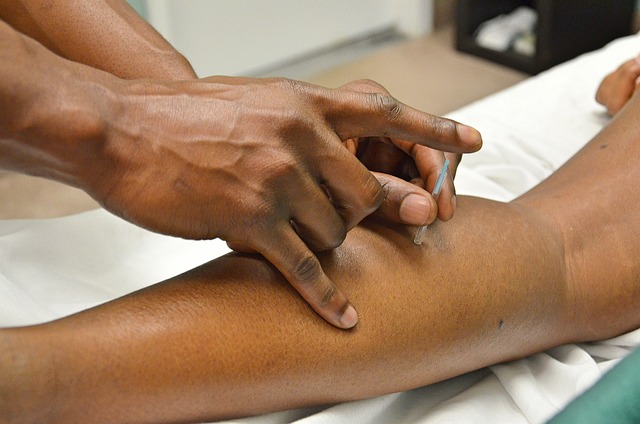Acupuncture for Pain

Acupuncture is a treatment modality from Asia that has been practiced and refined over thousands of years. And more recently, as a treatment, acupuncture has been gaining mainstream acceptance, especially for the treatment of pain.
While it may seem paradoxical that sticking needles into your body can help to reduce pain, the science has slowly been building that acupuncture has its place in pain management. Having personally worked at a pain management clinic helping patients with chronic pain conditions, I can also vouch for its efficacy. Acupuncture was one of the more effective modalities at helping patients with numerous different types of pain conditions.
Acupuncture Theory: A Brief Overview
Acupuncture treatment involves an understanding of what are described as the natural channels of energy flow throughout the body. These channels or “meridians” are thought to carry an energy referred to as qi. From a scientific perspective, the meridians appear to have a connection with the connective tissue of the body or “fascia” (Maurer 2019, Bai 2011). Fascia is the connective tissue that holds or glues everything in place, from muscles to organs. However, it is worth noting that the existence of qi is more speculative and has not been fully documented by modern scientific techniques.
To balance the energy in the body’s meridians, thin, single-use, stainless steel needles are inserted into different acupuncture points based on a patient’s presenting signs and symptoms. Typically, after needles are inserted, the patient will relax for a period of time to let the energy shift and rebalance. At the end of the treatment, the needles are removed. Depending on the acupuncture point location and the size of the needles, acupuncture can be close to painless, although larger needles or sensitive locations, like the hands and feet, can still be painful.
As a treatment, acupuncture appears to work, at least in part, through the opioid system or pain management system of the body (Wen 2010). If an opiate blocker is administered before acupuncture, the effects of the treatment are minimized.
Acupuncture and Pain
While historically, acupuncture was used for any health condition, some of the most robust scientific evidence shows its benefits for treating pain. Due to the large amount of research, there are numerous meta-analyses or “studies of studies” showing benefits for different pain conditions.
Knee Osteoarthritis
Knee osteoarthritis is generally considered to be pain from the long-term wear and tear on the knee joint. Knee osteoarthritis is common as we age and standard treatments include pain medication like ibuprofen and physical therapy. A meta-analysis of 18 studies looking at acupuncture combined with moxibustion, a type of heat treatment, found it to be more effective and safer than standard therapies when used for over six weeks (Zhu 2025).
Neck Pain and Stiffness

Neck pain is another common site for acute and chronic pain. A meta-analysis of ten studies found that acupuncture was more effective than standard treatment for reducing neck pain (Yu 2024). Total efficacy, pain scores, disability and range of motion were all better improved with acupuncture as compared to standard treatments.
Low Back Pain
Another common site of pain that can lead to disability is the low back. For treatment, acupuncture has robust evidence for reducing low back pain immediately following treatment and for the short-term (Wu 2024). Evidence is also suggestive of benefits for pain reduction over Intermediate time frames. The effect of acupuncture on disability due to low back pain is weaker but still suggesting positive findings.
Migraine Headaches
Migraines are a common pain condition that can include debilitating symptoms of throbbing head pain, light sensitivity, nausea and vomiting. Standard treatments often don’t provide satisfactory pain relief.
For migraine headaches, a meta-analysis on acupuncture also shows significant improvements (Yang 2024). When applied optimally, migraine frequency decreased by four migraines per month on average. Sixteen acupuncture sessions at three sessions per week provided the optimal benefits.
Fibromyalgia
As a pain condition, fibromyalgia is poorly understood. It presents as widespread joint and muscle pain, problems thinking, fatigue and poor sleep. Standard treatment approaches are not overly effective for reducing pain and can include significant side effects.
Similar to other pain conditions, acupuncture shows promise for improving fibromyalgia symptoms. A meta-analysis found that acupuncture reduced pain, improved mood and anxiety, decreased fatigue and stiffness while increasing sleep (Valera-Calero 2022). Benefits were clearly present in the short-term, but long-term studies are needed to verify the long-term benefits.
Conclusion
Acupuncture is a traditional treatment modality from Asia that has been used to support health for thousands of years. Modern research strongly supports the use of acupuncture for treating pain, often with better results than standard modalities and fewer side effects. For anyone struggling with pain, acupuncture is worth considering to see if it can help to provide relief.
While generally quite safe, acupuncture may be contraindicated or may need to be approached cautiously if a patient is pregnant, has a bleeding disorder, active skin infections, has an allergy to stainless steel or other health conditions.
If you have medical insurance, check your plan for coverage. Most plans offer acupuncture benefits for treating chronic pain, although they usually cap the number of visits per year and require a referral.



